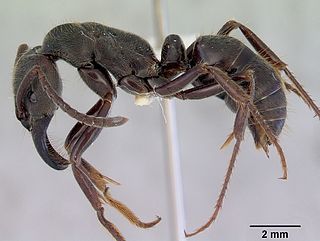
Ponerinae, the ponerine ants, is a subfamily of ants in the Poneromorph subfamilies group, with about 1,600 species in 47 extant genera, including Dinoponera gigantea - one of the world's largest species of ant. Mated workers have replaced the queen as the functional egg-layers in several species of ponerine ants. In such queenless species, the reproductive status of workers can only be determined through ovarian dissections.

Diacamma is a genus of queenless ants belonging to the subfamily Ponerinae. It is distributed from India to Australia and contains about 24 species.

Centromyrmex is a pantropical, though mainly Afrotropical, genus of ants in the subfamily Ponerinae. This ponerine ant was recorded for the first time in French Guiana and the most northerly point of recording was in Costa Rica. The specimens reported here were collected in a region of Amazon Forest with flight interception traps.

Cryptopone is a genus of ants in the subfamily Ponerinae. The genus has a worldwide distribution, with most species occurring in Asia. Workers range from very small to medium in size (1.7–6.1 mm), with the queens being slightly larger.

Platythyrea is a genus of predaceous ants in the subfamily Ponerinae and the sole member of the tribe Platythyreini.

Simopelta is a Neotropical genus of ants in the subfamily Ponerinae.

Thaumatomyrmex is a Neotropical genus of ants in the subfamily Ponerinae, found from Mexico to Brazil. They are notable for their pitchfork-shaped mandibles, which they use to capture millipedes of the order Polyxenida. The genus is a specialist predator of polyxenids, and one of only two ant genera known to prey upon polyxenids.

Boloponera is a genus of small ants in the subfamily Ponerinae. The genus contains the single species Boloponera vicans, known from a single worker specimen collected in leaf litter in the Central African Republic. It is sometimes referred to as Bry's ant after its discoverer, Brian Fisher.

Dolioponera is a genus of small ants in the subfamily Ponerinae containing the single species Dolioponera fustigera. The genus is known only from a few specimens from west and central Africa. Little is known about their biology, and males remain unknown.

Odontoponera is a small Southeast Asia genus of ants in the subfamily Ponerinae.

Emeryopone is a small genus of ants in the subfamily Ponerinae. The genus is distributed in Asia, from Israel to Indonesia. Little is known about their biology, and males remain unknown.

Buniapone is a monotypic genus of ants in the subfamily Ponerinae. Buniapone amblyops, the single described species, is found in Southern and Southeast Asia.

Iroponera is a monotypic genus of ants in the subfamily Ponerinae. Iroponera odax, the single described species, is known only from a few collections in Australia.

Brachyponera is a genus of ants in the subfamily Ponerinae.

Rasopone is genus of ants in the subfamily Ponerinae. The genus is restricted to Central and South America.

Paltothyreus is a monotypic genus of ants in the subfamily Ponerinae. Paltothyreus tarsatus, the single described species, is widely distributed in Sub-Saharan Africa. Workers are very large in size (17–20 mm); queens are similar to workers, but larger (23 mm) and winged.

Fisheropone is a genus of ants in the subfamily Ponerinae. Known from central Africa, it contains a single described species Fisheropone ambigua, and at least one undescribed species. Nothing is known about its biology.

Hagensia is a small genus of ants in the subfamily Ponerinae. Its two species are known only from coastal areas in South Africa. Workers are large (10.5–13.0 mm); queens are unknown, but gamergates occurs in both species.

Mayaponera is a genus of ants in the subfamily Ponerinae. It contains the single species Mayaponera constricta, found in Central and South America. Workers are slender and medium in size (6–7.5 mm).
Ophthalmopone is a ponerine genus of ants found in Sub-Saharan Africa. Workers are slender and large in size (8–13.5 mm). Queens seem to be absent, but gamergates present.



















